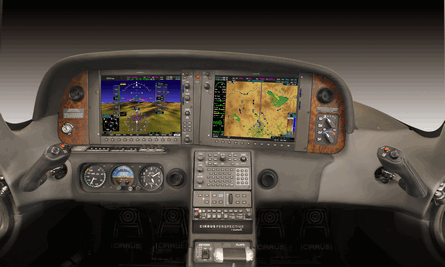Garmin's meteoric rise into the general aviation and corporate aviation cockpits has advanced one step further with the unveiling by Cirrus of the Garmin-built "Perspective" integrated cockpit at the EBACE business aviation convention in Geneva last week.
Set for first deliveries in third-generation SR22 models starting in June, the $48,000 G1000-based option features larger displays - up to 12in (305mm) from 10.3in - synthetic vision, dual solid-state attitude and heading reference system and safety features including a "level" button that straightens the aircraft in a panic situation. Although the avionics suite is officially an option, Cirrus chief executive Alan Klapmeier says all SR22s delivered from June will have the package after US Federal Aviation Administration certification is complete.
The announcement emphasises Garmin's intention to capture more market share ranging from Part 25 business jet cockpits to sport-light-size aircraft, says Gary Kelley, vice-president of marketing for Garmin. The company's highest-end placement to date is the Prodigy integrated avionics suite, a joint project with Embraer for the Phenom 100 very light jet and Phenom 300 light jet. Embraer reports more than 750 orders for the two aircraft, with deliveries of the Phenom 100 scheduled to begin later this year and the Phenom 300 one year later.
 |
|---|
© Cirrus |
Garmin did not bid to provide the integrated cockpit for Embraer's new MLJ and MSJ (renamed Legacy 450 and Legacy 500, respectively). "The timing wasn't right," says Kelley. The opening, however, gave avionics provider Rockwell Collins the opportunity to expand its growing customer list for advanced integrated avionics. Embraer in April selected the company to provide its Pro Line Fusion cockpit for both aircraft. Fusion, launched with a contract from Bombardier for its Global 5000 and Global XRS business jets last year, will also fly on Cessna's top-end Citation, the Columbus. Last week, Bombardier chose Fusion for its new all-composite Learjet 85.
While the Garmin win for the Cirrus would seem a sharp blow to Avidyne, the heritage provider of Cirrus avionics, hearty investments in research and technology could restore Avidyne's momentum sooner rather than later.
Bill Schillhammer, Avidyne director of international sales, says internally funded user interface studies with more than 150 pilots have led to advances that will boost safety for pilots using the company's integrated avionics. Results of that work will begin to emerge over the next few years, highlighted by next year's certification of the FMS 900W flight management system. Unlike traditional FMS products, Schillhammer says Avidyne's new FMS is designed to reduce "head-down" time by suggesting future waypoints based on geographic location. Schillhammer says the algorithm reduces user inputs by 75%.
In Europe, where there are more than 1,200 Avidyne-equipped aircraft flying, the company hopes to keep its momentum in the near term with its new $16,000 MLX 770 datalink system that will provide Avidyne-equipped European pilots with near real-time weather, analogous to what North American pilots receive with XM satellite weather.
Source: Flight International













